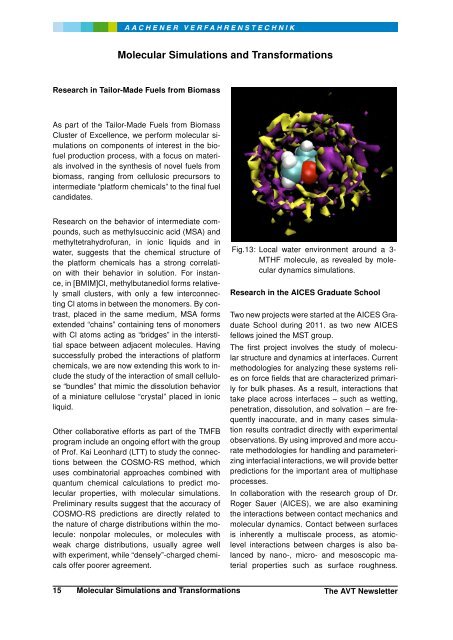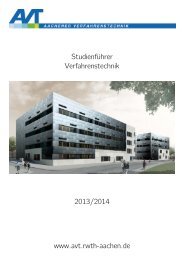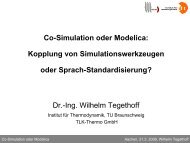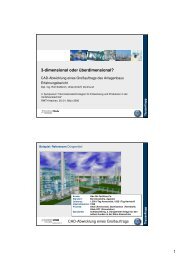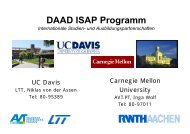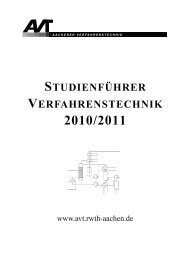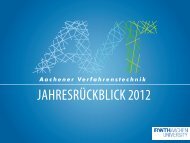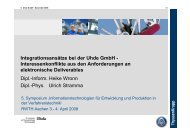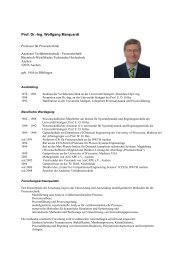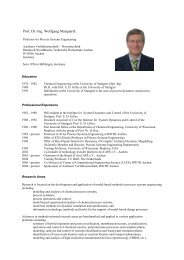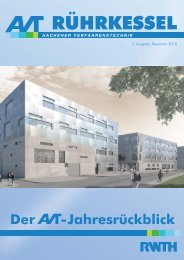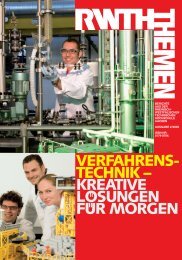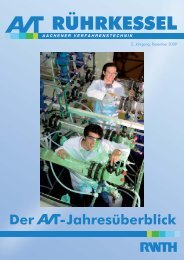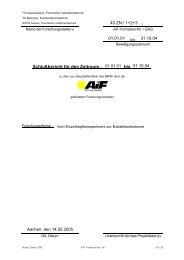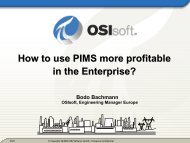Newsletter - Aachener Verfahrenstechnik - RWTH Aachen University
Newsletter - Aachener Verfahrenstechnik - RWTH Aachen University
Newsletter - Aachener Verfahrenstechnik - RWTH Aachen University
You also want an ePaper? Increase the reach of your titles
YUMPU automatically turns print PDFs into web optimized ePapers that Google loves.
Molecular Simulations and Transformations<br />
Research in Tailor-Made Fuels from Biomass<br />
As part of the Tailor-Made Fuels from Biomass<br />
Cluster of Excellence, we perform molecular simulations<br />
on components of interest in the biofuel<br />
production process, with a focus on materials<br />
involved in the synthesis of novel fuels from<br />
biomass, ranging from cellulosic precursors to<br />
intermediate “platform chemicals” to the final fuel<br />
candidates.<br />
Research on the behavior of intermediate compounds,<br />
such as methylsuccinic acid (MSA) and<br />
methyltetrahydrofuran, in ionic liquids and in<br />
water, suggests that the chemical structure of<br />
the platform chemicals has a strong correlation<br />
with their behavior in solution. For instance,<br />
in [BMIM]Cl, methylbutanediol forms relatively<br />
small clusters, with only a few interconnecting<br />
Cl atoms in between the monomers. By contrast,<br />
placed in the same medium, MSA forms<br />
extended “chains” containing tens of monomers<br />
with Cl atoms acting as “bridges” in the interstitial<br />
space between adjacent molecules. Having<br />
successfully probed the interactions of platform<br />
chemicals, we are now extending this work to include<br />
the study of the interaction of small cellulose<br />
“bundles” that mimic the dissolution behavior<br />
of a miniature cellulose “crystal” placed in ionic<br />
liquid.<br />
Other collaborative efforts as part of the TMFB<br />
program include an ongoing effort with the group<br />
of Prof. Kai Leonhard (LTT) to study the connections<br />
between the COSMO-RS method, which<br />
uses combinatorial approaches combined with<br />
quantum chemical calculations to predict molecular<br />
properties, with molecular simulations.<br />
Preliminary results suggest that the accuracy of<br />
COSMO-RS predictions are directly related to<br />
the nature of charge distributions within the molecule:<br />
nonpolar molecules, or molecules with<br />
weak charge distributions, usually agree well<br />
with experiment, while “densely”-charged chemicals<br />
offer poorer agreement.<br />
Fig.13: Local water environment around a 3-<br />
MTHF molecule, as revealed by molecular<br />
dynamics simulations.<br />
Research in the AICES Graduate School<br />
Two new projects were started at the AICES Graduate<br />
School during 2011. as two new AICES<br />
fellows joined the MST group.<br />
The first project involves the study of molecular<br />
structure and dynamics at interfaces. Current<br />
methodologies for analyzing these systems relies<br />
on force fields that are characterized primarily<br />
for bulk phases. As a result, interactions that<br />
take place across interfaces – such as wetting,<br />
penetration, dissolution, and solvation – are frequently<br />
inaccurate, and in many cases simulation<br />
results contradict directly with experimental<br />
observations. By using improved and more accurate<br />
methodologies for handling and parameterizing<br />
interfacial interactions, we will provide better<br />
predictions for the important area of multiphase<br />
processes.<br />
In collaboration with the research group of Dr.<br />
Roger Sauer (AICES), we are also examining<br />
the interactions between contact mechanics and<br />
molecular dynamics. Contact between surfaces<br />
is inherently a multiscale process, as atomiclevel<br />
interactions between charges is also balanced<br />
by nano-, micro- and mesoscopic material<br />
properties such as surface roughness.<br />
15 Molecular Simulations and Transformations The AVT <strong>Newsletter</strong>


